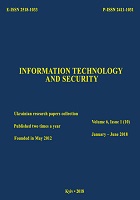Analysis of critical IT infrastructure designing problems for a ministry
DOI:
https://doi.org/10.20535/2411-1031.2018.6.1.153207Keywords:
Architecture, cloud services, global integration as a service, data center, critical ІТ-infrastructureAbstract
The problems of creating a critical IT infrastructure of the ministry are analyzed. The classic model of cloud services, which consists of three layers, is considered. It has been shown that the specificity of the tasks performed by the ministries (departments) puts the developer with increased requirements for reliability, safety, availability in the automation of their processes. As a result, it has been shown that the use of only these three layers to create a critical IT infrastructure of ministries (departments), even as a private cloud, is no longer sufficient. Several additional layers are proposed for the classical cloud service model, such as BaaS and XaaS. The first layer, Business as a Service (BaaS), includes automation of process management at the organizational level, including monitoring of performance indicators, analytical reports, data consolidation and centralized enterprise level integration. The second layer - everything as a service (XaaS), provides total automation of the industry level, including the introduction of industry standards, the automation of cross-integration of many enterprises. A further analysis of the developed model has been carried out and it has been determined that in order to create a single information space of the ministry (agencies) as an object of informatization with a critical IT infrastructure, it is necessary to put in its implementation a number of new possibilities. They stipulate the need to upgrade both the hardware infrastructure, both system and application software. Therefore, the creation of critical IT infrastructure with these capabilities requires the implementation of new specialized means of data transmission and storage of information. These tools are characterized by a number of key characteristics such as interactivity, multi-tieredness, heterogeneity, distribution, and dynamic modification of data structures during the lifecycle of critical IT infrastructure information systems in accordance with meta-models of the subject area based on metadata interpretation. All of the above points to the need to put into the model another GaaS last layer (the transition to global integration as a service). The last part of the article provides an analysis of the requirements for constructing a critical IT infrastructure.
References
M. Gorin, “Corporate Data Center: Beyond Technology”, Connect! World of Communication, no. 8, pp. 19-20, 2007.
I. Kirill, “Commercial data centers in Ukraine: a new stage of development”, Networks and business, no. 3 (52), 2010 [Online]. Available: http://www.sib.com.ua/arhiv_2010/ 2010_3/statia_3_1_2010/ statia_3_1_2010.htm.
D. S. Biriukov, and S. I. Kondratov, Critical Infrastructure Protection: Problems and Prospects for Implementation in Ukraine. Kyiv, Ukraine: NISS, 2012.
D. S. Biriukov, and S. I. Kondratov, The concept of critical infrastructure protection: the state, problems and prospects of its implementation in Ukraine, in Proc. International scientific and practical conference, Kyiv, 2014.
P. D. Rohov, B. O. Vorovych, and T. O. Vorona, “War in cyberspace”, Defensive Herald, no. 1, pp. 16-21, 2017.
S. O. Hnatiuk, V. M. Sydorenko, and O. P. Duksenko, “Modern approaches to critical infrastructure objects detection and identification”, Bezpeka ìnformacìì, vol. 21, no. 3, pp. 269-275, 2015.
S. O. Hnatiuk, R. S. Odarchenko, and V. M. Sydorenko, “Analysis of the methods of calculating the criticality of information systems”, in Proc. 9th International Scientific and Practical Conference "Integrated Intelligent Robot Engineering Complexes”, Kyiv, 2016, pp. 279-281.
L. Badger, T. Grance, R. Patt-Corner, and J. Voas, Cloud Computing Synopsis and Recommendations. Recommendations of the National Institute of Standards and Technology (Special Publication 800-146, NIST), 2012.
Y. Duan, G. Fu, N. Zhou, X. Sun, N. Narendra, and B. Hu, “Everything as a Service (XaaS) on the Cloud: Origins, Current and Future Trends”, in Proc. IEEE 8th International Conference on Cloud Computing, New York, 2015, pp. 621-628. doi: 10.1109/CLOUD.2015.88.
B. Viswanathan, “Understanding The Different Levels of Help Desk Support” [Online]. Available: https://project-management.com/understanding-the-different-levels-of-help-desk-support/.
Downloads
Published
How to Cite
Issue
Section
License
Copyright (c) 2020 Collection "Information technology and security"

This work is licensed under a Creative Commons Attribution 4.0 International License.
The authors that are published in this collection, agree to the following terms:
- The authors reserve the right to authorship of their work and pass the collection right of first publication this work is licensed under the Creative Commons Attribution License, which allows others to freely distribute the published work with the obligatory reference to the authors of the original work and the first publication of the work in this collection.
- The authors have the right to conclude an agreement on exclusive distribution of the work in the form in which it was published this anthology (for example, to place the work in a digital repository institution or to publish in the structure of the monograph), provided that references to the first publication of the work in this collection.
- Policy of the journal allows and encourages the placement of authors on the Internet (for example, in storage facilities or on personal web sites) the manuscript of the work, prior to the submission of the manuscript to the editor, and during its editorial processing, as it contributes to productive scientific discussion and positive effect on the efficiency and dynamics of citations of published work (see The Effect of Open Access).

